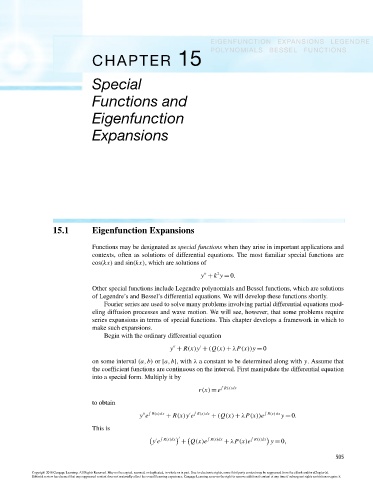Page 525 - Advanced engineering mathematics
P. 525
EIGENFUNCTION EXPANSIONS LEGENDRE
POLYNOMIALS BESSEL FUNCTIONS
CHAPTER 15
Special
Functions and
Eigenfunction
Expansions
15.1 Eigenfunction Expansions
Functions may be designated as special functions when they arise in important applications and
contexts, often as solutions of differential equations. The most familiar special functions are
cos(kx) and sin(kx), which are solutions of
2
y + k y = 0.
Other special functions include Legendre polynomials and Bessel functions, which are solutions
of Legendre’s and Bessel’s differential equations. We will develop these functions shortly.
Fourier series are used to solve many problems involving partial differential equations mod-
eling diffusion processes and wave motion. We will see, however, that some problems require
series expansions in terms of special functions. This chapter develops a framework in which to
make such expansions.
Begin with the ordinary differential equation
y + R(x)y + (Q(x) + λP(x))y = 0
on some interval (a,b) or [a,b], with λ a constant to be determined along with y. Assume that
the coefficient functions are continuous on the interval. First manipulate the differential equation
into a special form. Multiply it by
r(x) = e R(x)dx
to obtain
y e R(x)dx + R(x)y e R(x)dx + (Q(x) + λP(x))e R(x)dx y = 0.
This is
R(x)dx R(x)dx R(x)dx
y e + Q(x)e + λP(x)e y = 0,
505
Copyright 2010 Cengage Learning. All Rights Reserved. May not be copied, scanned, or duplicated, in whole or in part. Due to electronic rights, some third party content may be suppressed from the eBook and/or eChapter(s).
Editorial review has deemed that any suppressed content does not materially affect the overall learning experience. Cengage Learning reserves the right to remove additional content at any time if subsequent rights restrictions require it.
October 14, 2010 15:20 THM/NEIL Page-505 27410_15_ch15_p505-562

